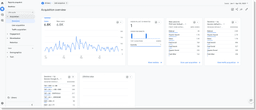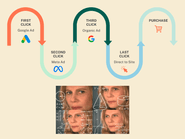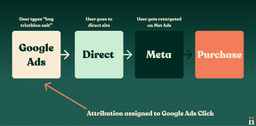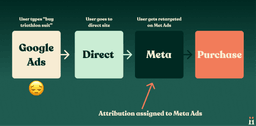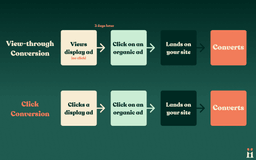
Google Ads & Analytics: Conversion Tracking Guide
Master Google Ads conversion tracking to measure campaign success. Learn how to set up tracking, analyse data, and optimise your ads for better results.
I warn you, if you don’t like digging into the finer details, this article might not be for you.
But if the words attribution model, data-driven attribution, last-click, measurement or tracking tags gets your heart racing like mine, then you’ve landed on the right page.
For as long as I can remember, when it comes to tracking conversions within Google Ads, we’ve always recommended using Google Ads native tracking, called Google Ads Conversion Tracking.
However, we regularly see advertisers opting for importing goals from Universal Google Analytics profiles. The biggest issue is that they don’t understand how the attribution models between Google Ads Conversion tracking and Google Analytics work differently. And more importantly, how they’re missing out on valuable signals and opportunities by using GA goals.
But then Google Analytics 4 (GA4) happened…
Google Analytics 4 dashboard is completely different to Universal Analytics.
Another spanner in the works for us advertisers is that GA4 uses a different attribution model than its predecessor universal analytics. In fact, GA4 is different in almost every way.
But for today, we’re going to be focusing on the different tracking options specifically for Google Ads. In addition:
- What is attribution, and why should you care?
- What is an attribution model?
- The difference between Google Ads & Universal Analytics tracking
- Google Analytics 4 Goals
- Our Recommendation
What is Attribution, and Why Should You Care?
In today’s digital landscape, consumers have more ways than ever to interact with brands. They might see an ad on social media, search for a product on Google, browse a website, switch devices and make a purchase on their mobile device.
Not to mention, the tightening of privacy laws like Apple’s iOS14 update and the third-party cookie depreciation, is making it even harder. But let’s save that for another day…
Complex customer journey’s makes attribution difficult and sometimes impossible to get right!
Complex customer journey’s like these make it difficult and sometimes impossible to determine which marketing channels and touchpoints are most effective at driving conversions and which are not.
That’s where attribution comes in.
Attribution allows marketers to identify and credit the touchpoints that contributed to a conversion, such as a sale or a lead. By understanding how customers interact with a brand and the role that different channels and touchpoints play in the conversion process, marketers can optimise their marketing campaigns and allocate their budget more effectively.
Brands are also taking matters into their own hands and including either post-purchase surveys or adding fields on their form to understand better how a person first became aware of their brand.
But let me be clear…
By no means is attribution black and white. All marketing platforms have their own unique way of attributing conversions, and in some cases, like when using Google Ads Conversion tracking, you can dictate the attribution model.
What is An Attribution Model?
An attribution model is a framework used in digital marketing to assign credit to the different touchpoints or channels that contributed to a conversion or sale. In other words, it measures the impact of various marketing channels and tactics on the customer journey.
Different attribution models use rules for assigning credit to touchpoints.
Let’s look at the attribution models you can select within Google Ads:
Last Click Attribution Model
Assigns all credit to the last-clicked ad and keyword. This model doesn’t consider any other channel or ad interactions that may have influenced a conversion.
In our eyes, last-click attribution is limiting because it ignores the impact of other ad interactions on the conversion path.
First click Attribution Model
Assigns all credit to the first-clicked ad and keyword.
In the performance world, this model is less common than last-click attribution. Still, it can be useful for campaigns where the initial touchpoint with the user is critical, such as branding or awareness campaigns.
Linear Attribution Model
Distributes credit equally across all ad interactions on the conversion path.
This model assumes that every touchpoint in the conversion path is equally important and contributes to the final conversion.
Compared with first and last click, this model provides a more comprehensive view of the conversion path and helps advertisers understand how different touchpoints contribute to the final conversion.
However, the linear attribution model can also be limiting because it assumes that every touchpoint is equally valuable, which may not be true. Some touchpoints may impact the user’s decision to convert more than others.
Time Decay Attribution Model
A Time Decay attribution model is typically used when advertisers want to give more credit to ad interactions that happened closer to the conversion day. This model assumes that the more recent an ad interaction occurred, the more likely it is to have contributed to the final conversion.
The Time Decay attribution model uses a 7-day half-life, which means that an ad interaction that happened 8 days before a conversion gets half as much credit as an ad interaction that happened 1 day before a conversion.
Half-life, time decay, attribution… I’m sure it’s all sounding pretty complicated at this point. We’ve never really used time decay at Farsiight, as it mainly attributes recent conversions, and in this day and age, it can take more than 7 days to convert users to customers.
Position-Based Attribution Model
It gives 40% credit to the first and last ad interactions and corresponding keywords, with the remaining 20% spread out across the other ad interactions on the path.
This model assumes that the first and last touchpoints are the most important and deserve the most credit but also recognises that other touchpoints along the way may have contributed to the final conversion.
Before data-driven attribution came along, we primarily opted for position-based at Farsiight.
Data-Driven Attribution Model
This is the latest model in Google Ads and is now the default and recommended attribution model to use by Google.
A Data-Driven attribution model is typically used when advertisers want to distribute credit for the conversion based on their account’s past data for the specific conversion action.
Unlike other attribution models that use predefined rules to allocate credit, the Data-Driven model calculates the actual contribution of each touchpoint across the conversion path based on historical performance data.
In the past, Google required a minimum amount of conversion data to use the data-driven attribution model. However, now it is available to advertisers even with new conversion actions. While this can be limiting as advertisers may not have insight into how the system is attributing conversions, Google’s automated solutions have become more effective in recent years, which provides some reassurance. As a result, we are currently transitioning most of our brands over to the data-driven attribution model.
The Difference Between Google Ads & Universal Analytics
Let’s dive into the differences between using Google Ads conversion tracking and importing goals from Universal Analytics. The first major difference we’ll explore is its impact on attribution.
Google Ads conversion tracking claims full attribution for any ad click that led to a conversion, no matter what channel was the last to receive a click in the path to a conversion.
On the other hand, Universal Google Analytics works on multi-channel attribution and will assign credit to the last channel that led to a conversion. So if Google Ads received the first click, but organic was the last click that led to the conversion, Google Ads wouldn’t receive any attribution.
To illustrate, let’s look at a customer journey below:
Google Ads conversion tracking assigns credit to the ad click
When using Google Ads conversion tracking, even if Meta Ads were the last channel the customer interacted with before purchasing, Google Ads would still receive attribution for the keyword “buy triathlon suit”. This is because Google Ads conversion tracking only focuses on assigning attribution for clicks that occurred on the platform and doesn’t consider other channels.
Now let’s look at what would happen if you were importing goals from Universal Analytics:
Last-click default attribution in Universal Analytics would assign credit to Meta Ads, and not Google Ads.
If you were importing goals from Universal Analytics, the result would differ. As shown by the sad face in the example, Google Ads wouldn’t receive any attribution because Universal Google Analytics’ default attribution model is last-click.
This means that the last channel that received a click before the conversion would be assigned attribution, which in this case is Meta Ads, and there lies the problem.
Benefits of Using Google Ads Conversion Tracking
More Signals To Optimise
With Google Ads Conversion tracking, you can better understand the impact of each keyword, channel, audience, demographic, and more on the path to conversion.
In the context of the customer journey example mentioned earlier, if Google Analytics goals were utilised, the keyword “buy triathlon suit” would not receive any attribution.
However, what if this keyword is highly effective in driving traffic to create awareness that eventually results in a sale, but because it fails to convert within the platform, you opt to disable it.
As a result, your sales plummet, and you are left puzzled about the cause.
By using GAds conversion tracking and receiving more signals, you can make smarter decisions about where to spend your budget.
Automated Bidding Strategies
Most accounts these days utilise automated bidding strategies due to the improved performance compared to manual bidding.
Automated bidding strategies rely on machine learning algorithms that use historical performance data to predict the likelihood of a particular ad or campaign leading to a conversion.
The more conversion data the algorithm can access, its predictions will be more accurate and effective.
When an account receives more conversion data, the machine learning algorithm can analyse the data and identify patterns that may not have been evident with smaller data sets. This allows the algorithm to make more informed decisions about bidding, such as when and how much to bid on a specific keyword, ad group, or campaign.
These days, we lean heavily into automated bidding strategies as they typically perform better against manual bidding options.
Options for automated bidding strategies in Google Ads interface
Receive View-Through Conversion Data
View-through conversions in Google Ads refer to conversions when a user sees but doesn’t click on your ad but later completes a conversion action on your website.
It’s much the same as Meta Ads tracking, where they report on click & view-through conversions.
These conversions are attributed to display or video ad campaigns and are only accessible when using Google Ads Conversion tracking and not Univeral Analytics Goals.
View-through conversions are important to analyse as they provide a more accurate picture of ad performance, help with optimization, and aid in attribution. You can use this information to adjust your targeting, bidding, and creative strategies to improve performance and increase conversions.
Now What About Google Analytics 4 Conversions?
Google Analytics 4 (GA4) uses a machine learning-based attribution model to determine which marketing channels and touchpoints drive conversions on your website.
The attribution model in GA4 considers all the interactions a user has with your website and assigns credit to the channels and touchpoints that contributed to the conversion.
This is a much better solution than universal analytics attribution as it looks beyond just the last touchpoint when assigning credit to each channel.
This means that even if a user first discovered your website through an ad and later converted through an organic search, both channels would receive some credit for the conversion.
However, like Universal Analytics, GA4 looks at multi-channel when distributing conversions, so you will still miss out on signals if you opt for this as the primary conversion action.
Our Recommendation
Now you know all about the different tracking methods, it’s time to discuss what we recommend.
And it hasn’t changed. We still recommend using Google Ads Conversion tracking as the primary method for optimising your campaigns for all the abovementioned benefits. It’s still the best method for driving the most performance and scaling Google Ads.
But that doesn’t mean you shouldn’t set up and measure Google Analytics 4 conversions.
GA4 provides a more holistic view of how Google Ads contributes to conversions and therefore is a great option for reporting on the ROI against your other marketing channels.
We recommend importing GA4 goals and using the “secondary” option. This means the conversion is observed and can be used in reporting but won’t be used to optimise bidding and campaign performance.

Josh Somerville
Josh is the co-founder of Farsiight and has spent the past 12 years scaling PPC campaigns.
Like what you read?
Learn more about digital, creative and platform strategies below.
